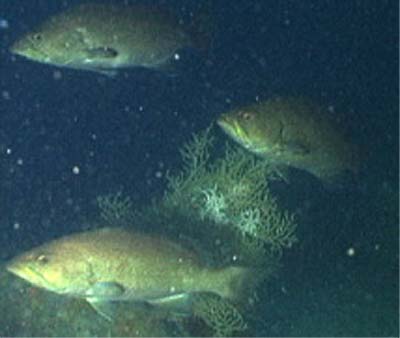The scamp groupers are a species of marine ray-finned fish belonging to the Serranidae and subfamily Epinephelinae. It is sometimes called the Broom Tail fish and is scientifically known by the name Mycteroperca phoenix. It is related to the gag and other slender-bodied groupers. An interesting fact about these groupers is that they are born as females but can change their sex to males after attaining maturity.
Scamp groupers are also popular among people who catch fish and love to eat them. If you want to find more about this fish, keep reading this article.
What Do Scamp Groupers Look Like?
Scamp groupers display four phases of colors and patterns. The first one shows a pale brown head and body, which is almost entirely covered by small, dark reddish brown spots. There is one on each scale and often forms clusters shaped like paws. saddle-like blotches are formed along the back that extends onto the flanks, the dorsal fins, and the anal fins. The pectoral fin will show a dark inner margin and a white outer one.
The second phase is more or less similar, but the spots are dark brown and limited to the upper body only.
In the third phase, which is the adult phase of scamp groupers, you will see a silvery grey head. The front of the body has dark reticulate, and the posterior portion of the body is also unclear. Some white spots will also be visible on the abdomen, the base of the caudal fin, and above the anal fin. Furthermore, you will notice black margins on the pectoral fins.
In the fourth phase, scamp groupers are bicolored. They show pale brown color on the anterior part, which changes to a darker shade on the dorsal fin. Juvenile scamps don’t show a bicolored phase; only matured ones do.
The average length of scamp groupers is 12 inches or 30 centimeters, though they can grow up to as much as 42 inches or 107 centimeters.
Where Do Scamp Groupers Live?
Scamp groupers are found in similar locations as most other types of groupers: in the waters of the Atlantic. Specifically the southern Atlantic. However, they are found in abundance the most in the Gulf of Mexico. Many of the biggest scamp fish ever caught were found in this place.
The smaller scamp groupers are also found in Florida in the northern part along the East Coast to North Carolina. The habitat stretches as far north as Massachusetts, although less dense.
Usually, you will be able to locate scamp groupers under different types of hard structures like rocks, shipwrecks, ledges, or reefs. Since they are bottom feeders, they are mostly found near the bottom, at a depth of around 75 to as much as 300 feet. During spawning seasons, they tend to stay in shallower words.
Can You Eat Scamp Groupers?
Yes, you can absolutely eat scamp groupers. Not only that, but the scamp grouper is also the tastiest grouper fish out there, making for a high table fare. The white meat and chunky flakes have a mild and distinct flavor, owning a classy feel to them. You can consider it a more delicious version of sea bass or halibut, because of the high moisture and subtle flavor, the culinary diversity of scamp groupers is high. Whether it’s grilled, pan-fried, or baked, it will be a great addition to the menu.
Fun fact: scamp groupers are often called “The Captain’s Meat” because they are served to the captains of boats. The meat of scamp groupers contains a large amount of protein, vitamins, and minerals, making it a nutritional diet. Moreover, since the number of calories in it is low, it is good for losing weight.
However, you may have heard that groupers are not entirely safe to eat, and there is nothing wrong with that information. Groupers have mercury inside their bodies. Consuming too much mercury can lead to several health risks. However, it is said that consuming one serving of scamp groupers per week is fairly safe. Still, it’s best not to eat it too frequently.
Is It Allowed To Catch Scamp Groupers?
Catching scamp groupers is allowed, whether for commercial purposes or recreational. All the areas are open for scamp grouper fishing. They are not an endangered species, so there aren’t a lot of regulations around them. However, recreational fishing for scamp groupers is closed from February 1- March 31.
In the Gulf of Mexico, there are size limits and bag limits imposed on the fishing of these groupers. The size limit is 16 inches, and the bag limit is 4 per person within the four-grouper aggregate bag limit.
How To Fish For Scamp Groupers?
Since scamp groupers are so tasty, naturally, there are lots of fishermen and hobbyists who crowd around to go catch them. If you want to catch this prized fish, then here are some tips to keep in mind:
Gear
To handle a medium to large-sized scamp grouper, a 6.5 to 7 feet medium to conventional heavy rod and reel will do. Since these fish usually stay at the bottom, you should use fishing weights to get the bait to that depth, but casting won’t be necessary. A more durable braided line will go a long way because the grouper is a tough fish, and you must fight the battle with it while catching it. For shallower waters, a lighter spinning tackle will be better.
Bait
It’s always the best choice to use live baits when fishing and grouper fishing is no exception either. As bait, you can use other smaller fishes like pin fish, sardines, scads, cigar minnows, spots, croakers, grunts, threadfins, and such. You can look up more details on the diet of scamp groupers and choose the bait that suits you the most.
Location
Even if you have the best bait, you won’t be getting that delicious dinner if you throw it at the wrong location. The favorite hangout spots for scamp groupers are the coastal waters, shoals, reefs, jetties, docks, piers, and wrecks. They are typically caught the most there. You can also check out breakwaters and mangroves to look for them. Always make sure not to throw the bait close to another fisherman!
Scamp groupers are fun to catch because they come with a challenge. And when you do catch them, it will come as a wonderful prize.












Pingback: Where do you catch grouper? | Reel Fishing Guru
Pingback: How To Fish for Grouper Off a Dock? | Reel Fishing Guru